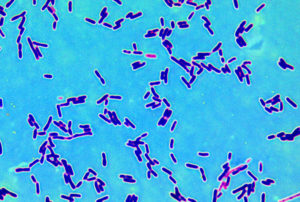Amazing persistence of the restroom microbial community.From NPR news:
What Microbes Lurked In The Last Public Restroom You Used?
The invisible world of the bathroom isn't pretty — unless you're a microbe. After scanning the microbial zoo of four public restrooms recently, a team of researchers found a diverse swarm of characters that persisted for months despite regular cleaning of the facilities. The goal of the study, published in the December issue of Applied and Environmental Microbiology, was to better understand how communities of bacteria and viruses can shift in these very public places across a couple of months.
To get their down-and-dirty readings, the researchers selected four bathrooms at San Diego State University... They checked two women's restrooms and two men's restrooms (a high-traffic and a low-traffic bathroom for each gender). The bathrooms were thoroughly cleaned at the study's start with bleach solution, which killed any existing germ communities.Then, during the following hours, days, weeks and months of human use, the researchers periodically swabbed soap dispensers, floors and toilet seats in all four restrooms for microbe samples.
Within one hour of sterilization, the bathrooms were completely recolonized with microbes — just as plants rapidly arrive and populate a newly emerged island. Fecal bacteria dominated, including on toilet seats and on soap dispensers — about 45 percent of the bacteria there were of fecal origin.
In all, the scientists found genetic traces of more than 77,000 distinct types of bacteria and viruses. (At least some of those species were likely dead or dormant, the scientists add; genetic testing detects them all, whatever their status.)
Patterns of regrowth and succession, as some species waned and others replaced them, were surprisingly similar from bathroom to bathroom; within just five hours the population mix in each room stabilized.
When the team tried growing cultures from different surfaces in each room, they found one set of live bacteria in overwhelming abundance: Staphylococcus. Staph's persistence in these studies points to its power as a potential pathogen, Gilbert says. Various versions are common on human skin and inside the nose and other orifices; they generally cause no problems, or trigger only minor skin infections. But staph infections can be serious, or even kill, if the bacteria get into bloodstream, joints, bones, lungs or heart.
Gilbert notes that none of the live Staph strains detected in the San Diego bathrooms showed signs of being antibiotic resistant. They were instead relatively harmless "skin bugs that happened to have lost their skin," he says. The team did find genes from MRSA hiding on the floor, as well as traces of some troublemaker viruses, including HPV and herpes virus.
Interestingly, although restrooms that were left open for use for up to two months were cleaned regularly with soap and water, the communities of microbes found there remained relatively unchanged for the full eight weeks of the study.
No need to be scared or grossed out by that finding, Gilbert says..."All human environments contain pathogens — your bedroom, the phone you're talking on, even the bugs inside of you could turn pathogenic at any time," Gilbert tells Shots. "But we desperately need them in our lives." Having a healthy community of good — or even just neutral — microbes can crowd out the bad ones. As we've learned from using broad-spectrum antibiotics in the human body, "sterilization is not necessarily good," he says. "Bacteria come back right away, and they might come back perturbed."
 For a while now it has become clear to some scientists that the prevailing view of Alzheimer's disease (buildup in the brain of 2 substances: amyloid and tau) isn't correct. Instead, some researchers feel that there is growing evidence that viruses are implicated as a cause of Alzheimer's and other neurodegenerative diseases (e.g., vascular dementia, ALS, Parkinson's disease, multiple sclerosis).
For a while now it has become clear to some scientists that the prevailing view of Alzheimer's disease (buildup in the brain of 2 substances: amyloid and tau) isn't correct. Instead, some researchers feel that there is growing evidence that viruses are implicated as a cause of Alzheimer's and other neurodegenerative diseases (e.g., vascular dementia, ALS, Parkinson's disease, multiple sclerosis).

 Just read about an international study that discussed how millions of bacteria and viruses circle the earth in the earth's atmosphere every day, and get deposited on land by rain and dust particles. Which could explain why similar viruses and bacteria are found in totally different environments in different parts of the world.
Just read about an international study that discussed how millions of bacteria and viruses circle the earth in the earth's atmosphere every day, and get deposited on land by rain and dust particles. Which could explain why similar viruses and bacteria are found in totally different environments in different parts of the world.  There are many posts on this site about the microbes within us (the microbiome) or around us, but the following article may be a real eye opener. Due to the permafrost melting (as in Alaska, northern Canada, Siberia, etc) from global warming, old infectious viruses and bacteria might be released from the thawing permafrost. This is what recently happened in Siberia, where melting permafrost released anthrax spores which killed 2300 reindeer and a 12 year old boy, and sickened at least 20 other people. From Scientific American:
There are many posts on this site about the microbes within us (the microbiome) or around us, but the following article may be a real eye opener. Due to the permafrost melting (as in Alaska, northern Canada, Siberia, etc) from global warming, old infectious viruses and bacteria might be released from the thawing permafrost. This is what recently happened in Siberia, where melting permafrost released anthrax spores which killed 2300 reindeer and a 12 year old boy, and sickened at least 20 other people. From Scientific American: Bacillus anthracis - Anthrax bacteria
Bacillus anthracis - Anthrax bacteria  Skin anthrax lesion on the neck
Skin anthrax lesion on the neck  Yes, even healthy newborns have a diversity of viruses in the gut - this is their
Yes, even healthy newborns have a diversity of viruses in the gut - this is their  This nice general summary of what scientists know about the microbial community within us was just published by a division of the NIH (National Institutes of Health). Very simple and basic. From the National Institute of General Medical Sciences (NIGMS):
This nice general summary of what scientists know about the microbial community within us was just published by a division of the NIH (National Institutes of Health). Very simple and basic. From the National Institute of General Medical Sciences (NIGMS):